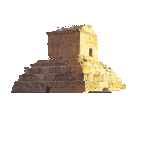|
Achaemenid Art
|
Stone
relief showing a charioteer
Achaemenid, 5th century BC
From Persepolis, south-west Iran
This relief of a charioteer
driving his horse comes from
the great Achaemenid Persian centre of Persepolis.
It was excavated in July 1811 by Robert Gordon who was part of a
diplomatic mission to Iran led by Sir Gore Ouseley, British Ambassador to
Persia from 1811 to 1814.
It originally decorated a staircase on the east wing of the north side of
the Apadana or audience hall. This structure, with an adjoining series of
private palaces and their ancillary buildings, was built on the western
side of a large artificial terrace on the edge of the
Marvdasht plain.
To the east lay the many-columned Treasury with adjacent storerooms,
offices and barracks. The Apadana reliefs show delegations from many parts
of the Persian Empire bringing tribute and gifts.
The citadel terrace of Persepolis was started by Darius I (521-486 BC) in
about 500 BC, continued under his son Xerxes I (485-465 BC) and grandson
Artaxerxes I (464-425 BC) with further additions and alterations by
Artaxerxes III (358-338 BC). The palaces borrowed elements from many
traditions - Median, Mesopotamia, Greek and Egyptian. The citadel formed
part of a complex including the fortified hill to the east, the royal
tombs in the cliff of Naqsh-i Rustam, where Darius and three of his
successors were buried, and a series of palaces on the plain below.
Height: 55 cm
Width: 77 cm
Back to
the top |
Back |




